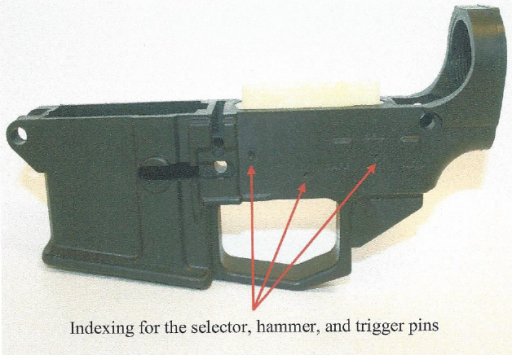ATF has ruled that it is a firearm, despite the inclusion of a biscuit in the fire control well, which the rest of the receiver is injection molded around. You can find the determination letter here.
Unlike “castings” or “blanks” which are formed as a single piece so that a fire-control cavity has not been made, EP Arms uses the biscuit specifically to create that fire-control cavity during the injection molding process. As described in your letter, it appears that the sole purpose of the “biscuit” is to differential the fire-control area from the rest of the receiver and thus facilitate the process of making the receiver into a functional firearm. ATF has long held that “indexing” of the fire-control area is sufficient to require classification as a firearm receiver. Based upon the EP Arms manufacturing process, it is clear that the “biscuit” serves to index the entire fire-control cavity from the rest of the firearm so that it may be easily identified and removed to create a functional firearm.
Keep in mind that courts are generally highly deferential to agency determinations, so I wouldn’t give this much of a chance in court. But it’s noteworthy that ATF has “long held” that indexing constitutes creating a receiver. Where in the Federal Register can that be found? Can’t find anything in the code of federal regulations either. It’s probably found in other determination letters. This isn’t rule of law, it’s rule by bureaucratic whim.


The ATF is clearly racist as they are insisting on segregation. They want to force 80% receivers to either be all black or all white. They object to the mixing of colors.
I wouldn’t be so sure this is not appealable wrt to the agency’s determinations. There was a case just this term (one of the EPA cases) where the dissent made it clear that Auer deference (that deference to agency’s interpreting their own regulations you pointed out) was not long for this world. For obvious reasons, the ATF is a very good agency to raise this issue of administrative agencies in charge of interpreting their own regulations.
I don’t have a copy of the letter anymore, but back when I was active on homebuilt gun and gun design forums, I recall when the ATF determination letter was issued that said that you couldn’t even have divots in the receiver blank to show where to drill AR15 FCG pin holes.
I thought it was BS then and now, but it is BS ATF has stood by for several years (at least six or seven).
While I think the ATF’s determinations need to be held to strict scrutiny (even if the Courts don’t yet agree), and while I think their rule of “any machining in the FC cavity makes it a gun” is untenable…
I think they’re right about this specific lower.
The law says being “readily converted” makes a receiver a “firearm” even if it’s not actually so converted yet.
And that lower, if the letter is correct at the technical level, is requires only popping out the plastic “biscuit” and drilling three holes … that are conveniently marked for you in the casting.
As much as I don’t really like the ATF, that sure does read as “readily converted” per 18 USC, in a way that a traditional “80%” casting does not.
You CAN’T just “pop out” the biscuit. The topology of the biscuit physically locks into the receiver as it’s cast around the biscuit. They did that deliberately, so the biscuit is wholly non-removeable without machining it out.
ATF’s objection is basically that, by using an insert that (while mechanically as strong as the rest of the receiver, and integrally locked so it has to be machined out (just as if EP simply cast the receiver solid in one cast without a differenciating fire control pocket biscuit), the fact that the biscuit is a different color so you can mill it out by eyeball is enough to make teh receiver blank a “firearm”. (In other words, marking the FCG pocket location with a hair-thin scratch would also cause them to rule an 80% blank cast from solid aluminum like every other AR cast blank, but with a scratch defining the outline of the FCG, would be a “firearm”.)
Likewise, just having dimples where the FCG pinholes need to be drilled are, in and of themselves sufficient for ATF to rule this blank a firearms receiver, even if it had been cast in one step as a homogenous block of black polymer.
I agree that these administrative determiniations should be held to strict scrutiny, because the processes and debates that result in these internal (and, in most cases, concealed from public view) decisions never receive the public input and scrutiny that statutory law has — there is simply no checks or balances comparable to what a bill has to go through to become law, yet these executive bureaucratic decisions are treated as law.
(I completely agree that the standards for AR lowers ought to be published somewhere and not subject to arbitrary change – just like I think “letters” from the ATF ought to be held as binding against the ATF changing its mind later.)
Where have you been for the last seventy-five years?
I know it’s nothing new, but it bears repeating.
Could one market investment casting molds, maybe with embedded metal reinforcements and helicoil inserts, designed for injection of high strength epoxy?
Outside of the gun community, the fact that the ATF generally disregards the administrative procedure act is almost completely unknown. None of my professors at law school (including ones that specialized in APA stuff) had any knowledge that any agency was behaving this way. Of course, none of them cared about that, or about anything else going on in the real world.
So what happens if you bought these lowers, what do you do with them?
Good question. My solution would be to keep quiet and plead ignorance :)